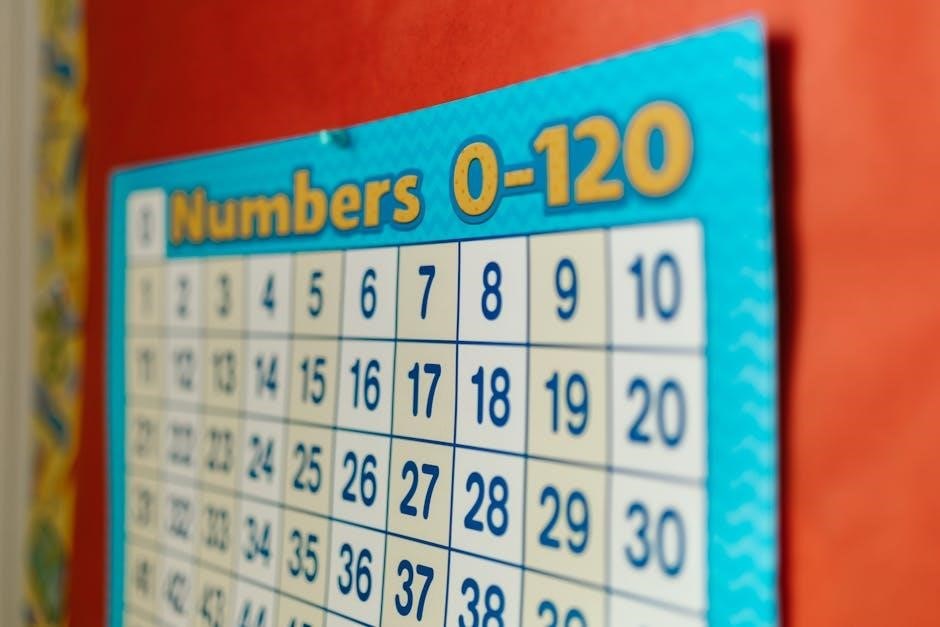A 120 chart is a grid displaying numbers from 1 to 120, arranged in rows of 10, helping students visualize number patterns and understand place value concepts.
What is a 120 Chart?
A 120 chart is an educational tool designed as a grid containing numbers from 1 to 120, arranged in rows of 10. It helps students recognize number patterns, understand place value, and develop counting skills. The chart is particularly useful for introducing concepts like counting forward and backward, skip counting by 2s, 5s, and 10s, and identifying sequences. Its structured layout makes it easy for young learners to visualize number relationships and transitions, especially beyond 100. The chart is widely used in classrooms for students in pre-kindergarten through second grade, providing a hands-on, visual method to explore numerical concepts and math operations.

Importance of the 120 Chart in Education
The 120 chart is a foundational tool in early math education, helping students build a strong understanding of number patterns, counting, and place value. Its structured layout allows young learners to visualize numbers beyond 100, making abstract concepts more tangible. The chart supports the development of critical math skills, such as skip counting, backward counting, and identifying sequences, which are essential for future math operations. By using a 120 chart, educators can introduce students to larger numbers in an organized and engaging way, fostering a deeper connection to numerical relationships and preparing them for advanced math concepts. It also encourages interactive and collaborative learning in the classroom.

Educational Benefits of the 120 Chart
The 120 chart enhances number sense, supports counting skills, and introduces place value concepts, providing a visual tool for understanding number sequences and relationships.
Developing Number Patterns and Counting Skills
The 120 chart is an excellent tool for helping students recognize and extend number patterns, fostering counting skills, and building a strong foundation in numeracy. By arranging numbers in a grid, the chart provides a visual representation of sequences, making it easier for students to identify relationships between numbers. Activities such as counting forward and backward, skip counting by 2s, 5s, and 10s, and identifying missing numbers encourage students to explore number patterns interactively. This structured approach helps students develop fluency in counting and enhances their ability to recognize how numbers progress and relate to one another. It also supports the development of mental math skills and number sense.
Understanding Place Value Concepts

The 120 chart is a powerful tool for teaching place value concepts, as it visually demonstrates how numbers progress and helps students recognize the relationship between tens and ones. By seeing numbers arranged in rows of 10, students can easily identify how each digit represents a specific place value. For example, in the number 123, the “1” represents hundreds, the “2” represents tens, and the “3” represents ones. This structured format allows students to visualize how numbers build upon one another, reinforcing their understanding of place value principles. This clarity aids in developing mental math skills and prepares students for more complex number operations and transitions to higher place values.

Activities Using the 120 Chart
The 120 chart offers versatile educational activities, including counting forward and backward, skip counting, identifying missing numbers, and interactive learning exercises to enhance math skills and engagement.

Counting Forward and Backward
Counting forward and backward using a 120 chart helps students master number sequences and transitions. Starting from any number, learners can move sequentially, enhancing their understanding of numerical order. This activity reinforces the ability to identify numbers before and after a given point, fostering fluency in counting. For example, students can begin at 50 and count up to 60 or start at 120 and count backward to 110. The chart’s visual layout makes it easier to track progress and recognize patterns, especially when moving past 100. Such exercises build foundational math skills and prepare students for more complex operations, like addition and subtraction, by creating a mental framework for number sequences.
Skip Counting by 2s, 5s, and 10s
Skip counting on a 120 chart enhances number pattern recognition and foundational math skills. By counting in increments of 2, 5, or 10, students learn to identify multiples and understand relationships between numbers. For example, skip counting by 2s helps distinguish even and odd numbers, while counting by 5s or 10s introduces concepts of grouping and place value. This activity also prepares students for multiplication and division by familiarizing them with number sequences. Using the chart, learners can start at any number and count forward or backward, making it an engaging way to build fluency in math operations and apply real-world applications, such as handling money or measuring quantities.

Design and Formatting of the 120 Chart PDF
The 120 chart PDF is a neatly structured grid of numbers 1-120, often in 12 rows of 10. It is designed for easy printing and includes formatting options like black and white versions to save ink while maintaining clarity.
Structure and Layout of the Chart

The 120 chart is organized as a grid with numbers 1 through 120, typically arranged in 12 rows of 10 numbers each. This layout allows for easy visualization of number sequences, making it simple for students to follow patterns and identify relationships between numbers. Each row contains consecutive numbers, progressing from left to right, which helps in understanding counting and place value concepts. The structure is consistent, with each row starting where the previous one ended, ensuring a logical flow. This clear and orderly arrangement makes the chart an effective tool for teaching various math skills, including counting, skip counting, and identifying missing numbers. The grid format also supports activities like counting forward or backward, skip counting by 2s, 5s, or 10s, and exploring number relationships in a visually structured manner. Additionally, the chart’s design ensures that students can easily locate specific numbers, fostering a sense of numerical awareness and fluency. The consistent and repetitive layout of the chart helps reinforce math concepts in a way that is both engaging and accessible for young learners. By using the 120 chart, educators can provide students with a foundational tool that supports their mathematical development and understanding of number patterns. The chart’s simplicity and clarity make it an indispensable resource in early math education, allowing students to build a strong numerical foundation.
Downloading and Printing Options
The 120 chart is readily available as a printable PDF, making it easy to download and use in classrooms or at home. To obtain the chart, simply click on the provided link or image, and it will be saved to your device. The PDF format ensures compatibility with most devices and printers. Once downloaded, the chart can be printed on standard paper, offering a durable and clear visual tool for learning. For added convenience, some versions include multiple charts per page, allowing educators to distribute them easily to students. Additionally, the chart can be laminated or placed in dry-erase pockets for repeated use. This accessibility makes the 120 chart a practical resource for teaching various math skills to students. Its straightforward download and print process ensures that educators can quickly integrate it into their lesson plans. Furthermore, the PDF’s versatility allows for easy sharing among colleagues or parents, promoting collaborative learning environments. By providing a seamless way to access and print the chart, educators can focus on leveraging its educational benefits without hassle. The simplicity of the download and printing process underscores the chart’s value as a user-friendly educational tool. Overall, the 120 chart PDF is designed to be easily accessible and adaptable for diverse teaching needs. Teachers can print it in color or black and white, depending on their preferences, ensuring flexibility in its use. This ease of access and printing makes the 120 chart an indispensable resource for fostering numeracy skills in students. The availability of the chart in PDF format also ensures that it remains a cost-effective and efficient tool for educators seeking to enhance their math curriculum. With just a few clicks, the chart is ready to be used, making it a convenient solution for busy educators. Its portability and printability further enhance its utility, allowing it to be used in various educational settings. In summary, the 120 chart PDF is a readily accessible and practical tool that educators can easily download, print, and utilize to support student learning. The straightforward process ensures that the chart can be quickly integrated into daily lessons, providing students with a valuable resource for understanding number patterns and math concepts. By offering a simple and efficient way to obtain and print the chart, educators can maximize its potential in the classroom. The 120 chart PDF is a testament to the convenience of digital resources in modern education, offering a seamless experience for both teachers and students. Its availability in multiple formats and ease of printing further solidify its place as a essential educational tool. With the 120 chart PDF, educators have a reliable and accessible resource to teach counting, skip counting, and place value concepts effectively. The chart’s PDF format ensures that it can be easily shared and printed, making it a versatile addition to any math curriculum. In conclusion, the 120 chart PDF is a practical and user-friendly resource that educators can download and print with ease, providing students with a valuable tool for learning and exploration. The simplicity of the process ensures that the chart can be quickly implemented in various educational settings, supporting the development of essential math skills.

Classroom Applications of the 120 Chart
The 120 chart is a versatile tool for teaching counting, skip counting, and place value concepts, making it an essential resource for interactive and engaging math lessons.
Using the Chart for Math Operations
The 120 chart is an excellent tool for introducing and reinforcing various math operations. Teachers can use it to demonstrate addition and subtraction by moving sequentially through numbers. For example, students can count forward to practice addition or backward to understand subtraction. The chart also supports multiplication and division concepts through skip counting activities. By identifying patterns, students can visualize how numbers relate to each other, making abstract math concepts more concrete. Additionally, the chart helps students identify missing numbers, understand place value, and recognize even and odd numbers. These activities not only enhance number sense but also build foundational skills for more complex math operations.

Interactive Learning with the 120 Chart
The 120 chart fosters interactive learning by engaging students in hands-on activities. Teachers can use it to create dynamic lessons where students count aloud, skip count, or identify patterns. For instance, students can highlight numbers during skip counting exercises or circle multiples of specific numbers. The chart also encourages collaborative learning, as students can work in pairs or groups to complete tasks like filling in missing numbers or identifying sequences. Its visual layout makes it easy for students to connect numbers and see relationships, enhancing their understanding of math concepts. These interactive approaches make learning enjoyable and effective, helping students develop a strong foundation in number sense and mathematical reasoning.
The 120 chart PDF is a versatile tool for teaching counting, skip counting, and number patterns, offering an interactive and visual approach to mastering foundational math skills effectively.
Final Thoughts on the 120 Chart PDF
The 120 chart PDF is a highly effective educational tool, offering a structured and visual approach to learning number patterns, counting, and place value concepts. Its simplicity makes it accessible to students of various ages, from pre-kindergarten to second grade. By providing a clear sequence of numbers from 1 to 120, it helps students transition smoothly from counting in tens to hundreds. The chart’s versatility allows for diverse activities, such as counting forward and backward, skip counting by 2s, 5s, and 10s, and identifying missing numbers. Teachers can customize it to suit different learning needs, making it an invaluable resource for interactive and engaging math lessons. Its PDF format ensures easy downloading and printing, making it a practical addition to any classroom setting.